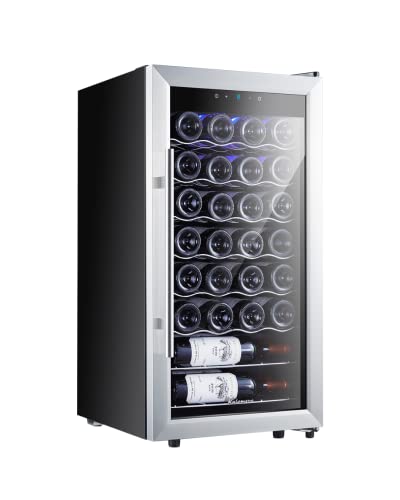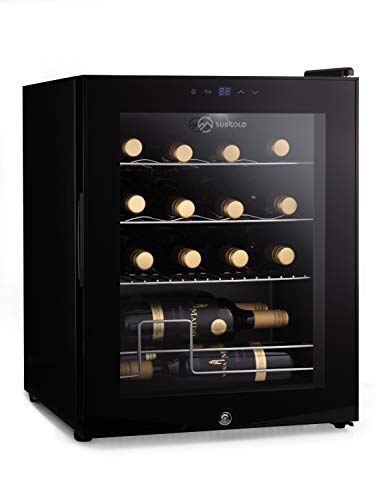12 Companies Leading The Way In Wine Cooler And Fridge
페이지 정보
작성자 Marcelo 작성일 24-12-24 10:29 조회 4 댓글 0본문
 How a Wine Cooler and Fridge Can Help Preserve Your Cabernet Sauvignon and White Zinfandel
How a Wine Cooler and Fridge Can Help Preserve Your Cabernet Sauvignon and White Zinfandel Keep your Cabernet Sauvignon and White Zinfandel at their ideal serving temperatures by using wine refrigerators. Some wine refrigerators, like the KitchenAid Undercounter Wine Cellar (R) control the humidity inside to protect labels and wine from mould.
Keep your Cabernet Sauvignon and White Zinfandel at their ideal serving temperatures by using wine refrigerators. Some wine refrigerators, like the KitchenAid Undercounter Wine Cellar (R) control the humidity inside to protect labels and wine from mould.Traditional refrigerators can be dangerous to your wine's flavour. This is why designated wine fridges are in place.
Optimal Temperature
A wine fridge is an excellent way to keep your selection of wines at the perfect serving temperature. This makes it easier to serve them. The temperature of the wine should be maintained constant and stable to ensure the taste and aroma of the wine while also slowing the aging process. The temperature of the wine should be a little lower than the room temperature in order to prevent the wine from getting too cold and losing its flavor.
The most efficient wine coolers are made to maintain a temperature between 54 and 57 degrees Fahrenheit (11 and 14 Celsius). This is a great temperature range for long-term storage, because it can slow the aging process and prevent the wine from becoming dry. The temperature should not be too high, as this could cause oxidation or other problems.
You can choose a single-zone wine refrigerator to keep all your wine collection, or you can get a dual-zone mini wine refrigerator refrigerator which allows you to divide the wine into two different zones to control the temperature. For instance, you could store your red wines in one zone and your white wines in the other in order to easily serve them at the perfect temperature for each kind of wine. This will enhance the drinking experience and make it easier for you to host a cocktail party or dinner, as you can simply move the bottles into the appropriate zone prior to the night before.
Some wine refrigerator models will come with a user's manual that contains information about specific temperature settings. This document is essential to understand the features of temperature control on your wine cooler. It is also an excellent idea to check regularly the temperature of your wine refrigerator since fluctuations can occur. It is recommended to keep the wine refrigerator away from sunlight and heat sources, as this will help to prevent the interior of the fridge from getting too hot. It is advised to not open the wine refrigerator too often, as this may cause the temperature to fluctuate.
Humidity Control
Humidity plays a key role in the storage of wine. Low levels of humidity can cause seals and corks to dry out. This weakens the seal and allows oxygen to get into the bottle. This can alter the taste of the wine, and lead to off-flavors. High humidity can encourage the growth of mildew and mold, which can affect the labels on wine bottles. A wine cooler that has integrated humidity control can help you achieve optimal aging conditions for your wine collection.
The ideal range for humidity is 50 to 50% to. Some wine fridges feature a dehumidifying feature that aids in controlling humidity by removing excess moisture. It is crucial to keep in mind that high levels of humidity can influence the quality and readability on labels for wine. The consistent humidity levels also aid in even aging and the development of complex tastes over time.
Humidification techniques for your wine fridge are simple and easy to apply. The most commonly used method is to put a small tray of water at the bottom of your refrigerator. As time passes the water will evaporate and increase the humidity in your wine refrigerator. You can also install a humidifier specifically designed for use in small spaces. Some are energy efficient and feature a the ability to adjust the humidity level. be adjustable.
Another alternative is to use baking soda, which is a natural properties to absorb moisture. Simply open a container of baking soda and place it in your fridge to help reduce moisture. You can also make use of silica gel packs which are often used to package electronic items as well as food items. Just be sure to replace these periodically.
Some wine refrigerators have humidity control systems which automatically regulate humidity levels in accordance to pre-set parameters. They are generally more precise than passive methods, and can be especially useful if you have a large wine cellar that has various humidity requirements for different kinds of wines. Professionally designed wine cellars have built-in cooling units that provide a controlled environment for aging your collection. These are usually best for high-value wines that require a stable, secure environment for aging.
Noise Reduction
Wine coolers and refrigerators are a great investment for those who wish to maintain the quality of their wine. These appliances can generate noise during operation, which can be disruptive or distracting. Fortunately, there are several ways to reduce the level of noise produced by these units.
One of the primary sources of noise in wine chiller under counter refrigerators is compressor cycling. This process involves the circulation of refrigerant to cool the interior of the fridge, and could result in groaning and buzzing noises. Due to this, it is important to ensure that the refrigerator is placed on a level and stable surface to avoid creating noise or vibrations.
Internal Vibrations
Another common source of noise in the wine fridge wine storage is the sound of scraping or rattling caused by bottles moving against each other and on the shelves. This can be reduced by making sure that the bottles are safely stored and securely packed together to minimize movement. It is also beneficial to use wooden shelves or racks rather than metal to help absorb some of the noise.
The proper ventilation will also reduce the level of noise emitted by the wine refrigerator. Cleaning the fridge regularly is crucial to remove dust and debris which can build up and block air flow. In addition, it is recommended to place an isolation pad made of rubber under the fridge to separate it from the floor and reduce any vibrations that may cause noise.
Typically, wine refrigerators generate 35 to 45 decibels in their normal operation. This is similar to the background sound heard in a quiet suburban home or library and is considered an appliance that has the lowest noise level.
If your wine fridge is making louder sounds than usual, it's often helpful to consult a manufacturer's troubleshooting manual, or call an expert to come out and repair it. This will allow you to determine if the appliance is operating properly or if there is a more serious problem present. The technician can diagnose the problem and fix it if necessary.
Versatility
While fridges are ideal for keeping drinks cold however, if you're looking for a place to preserve and mature your wine, a regular refrigerator will not provide the ideal environment to do so. Utilizing a wine cooler will ensure that your bottles are kept at an optimal temperature, protected from damaging vibrations and keeps an extremely high humidity to ensure optimal storage and flavor.
The temperature of standard refrigerators fluctuates because they are opened several times a day. This can cause damage to your wine, as it takes time for the temperature level to return to its ideal. A wine fridge on the other hand typically has a lock and smaller openings that reduce the temperature and exposure to air. Additionally, wine fridges typically come with a vibration absorption system that can help protect your wine from damage caused by compressor vibration.
A wine fridge can also help prevent the unwanted smells that come from other foods in the refrigerator from getting into your narrow wine refrigerator bottle. This can affect the taste of the wine and leave an unpleasant odor on the cork.
Additionally the wine fridge can store white and red wines. Often, they come with display shelves designed to support your bottles in order to showcase their beautiful label artwork. Certain wine refrigerators come with dual zones that permit you to chill, age and store wines at different temperatures. A wine refrigerator is essential for every home, whether you are a wine collector or simply enjoy sharing a glass of wines with friends. They are available in various sizes and styles that include freestanding units as well as built-in models. Find your perfect wine fridge.
- 이전글 This Research Will Perfect Your Gold News: Learn Or Miss Out
- 다음글 This Is The Ultimate Cheat Sheet On Boot Scooter
댓글목록 0
등록된 댓글이 없습니다.